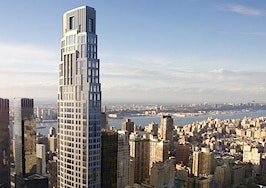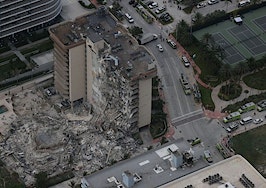Luxury residences offer a promise of refinement and pedigree to their residents. Elegant chandeliers, coveted balconies and other exclusive amenities are often just a few of the attractions that draw in buyers. But, it’s surprisingly not uncommon for luxury condos to later reveal glaring construction defects after the veneer has worn off.
This alarming, yet somewhat commonplace, phenomenon was brought into the spotlight this week when a luxury high-rise condo tower near Miami partially collapsed, seemingly unprompted. As of Friday afternoon, 159 building residents were still unaccounted for in the wake of the catastrophe. Four were confirmed dead.
“You know what kind of ripple effect that’s going to have in Miami?” Steven Sladkus, a partner at Schwartz, Sladkus, Reich, Greenberg, Atlas LLP who often represents residents in luxury condo construction defects cases, told Inman. “Whoever the buildings department [is] there, is going to be sending out squads inspecting buildings to see if it is a danger that could occur in any other buildings, or what caused this.”
Recent high-profile luxury condo construction defects
The case of the partial collapse of Champlain Towers South in Surfside, Florida, is one of the more extreme. The building, which was constructed in 1981 was just about to undergo extensive upgrades as part of its 40-year recertification process. Those upgrades included a new roof, and repairs to rusted steel and concrete deterioration, which are common to waterfront buildings of that age that have been exposed to ocean salts for extended periods. An engineer had identified those repairs through the building recertification process, but, as of yet, experts involved in the process say there’s no evidence to suggest that those repairs had to do with the building’s collapse.
Kenneth S. Direktor, a lawyer who represents the resident association that operates the Champlain Towers South, told the New York Times that engineers often have a good idea of where repairs need to be made, but may not know the full extent of damage until they begin working on the building. Charlie Danger, the former Miami-Dade County building chief who is now retired, told the Times that one area of concern with buildings close to the ocean is a poorly protected rebar that rusts and leads to concrete spalling (chipping or breaking of the concrete).
In the wake of the tragedy, questions about past red flags at the building have come to light. When construction took place on a neighboring complex last year, Champlain Towers resident Raysa Rodriguez told the Times that residents could feel the whole building shake, which raises the question of whether impacts from the neighboring construction could have played a role in Champlain Towers’s collapse.
In 2015, one of the complex’s residents filed a lawsuit against the condo association, claiming poor building maintenance resulted in water damage to her unit from cracks in an outside wall. That resident’s attorney, Daniel Wagner, told the Times that the lawsuit involved the building’s “structural integrity and serious disrepair.”
Furthermore, a 2020 study completed by a Florida International University professor revealed that the Champlain Towers complex started showing signs of land subsidence (sinking or settling) in the 1990s, as shown through an analysis of space-based radar. Although land subsidence is not uncommon in the area, Champlain Towers was the only place on the east side of the barrier island where subsidence surfaced in the study.
Another luxury condo that’s recently gained attention for its defects is 432 Park Avenue, a New York high rise that had a brief moment in the spotlight as the tallest residential building in the world at 1,400 feet high. Despite the building’s hype and multimillion dollar cost to live there, just six years after it was completed, details have come to light about resident complaints over the tower’s defects, including plumbing and mechanical problems that have yielded costly water damage, unreliable elevators and creaky walls, all of which may be traced back to the tower’s looming height, according to evidence obtained by the Times.
Those issues have led to some residents incurring hundreds of thousands of dollars in costly repairs, as well as a number of lawsuits directed at the developers.
In the early 2010s, as property values started climbing in New York City and developers sought to cash in on the market, condo construction and conversions rapidly increased, giving rise to similar construction defects as developers hastily scrambled to get jobs done. Concrete started falling from the facade and balconies of 500 Fourth Avenue, a 12-story condo building in Brooklyn, in 2013, just three years after the building was opened to residents.
Why these issues persist

Steven Sladkus | Credit: Schwartz, Sladkus, Reich, Greenberg, Atlas LLP
“I’ve been seeing over the years, a steady pace of condominium buildings or new construction or gut rehabilitated buildings for sale that are offering apartments for sale where there are plenty of construction defects and my office is still continuously prosecuting those types of cases and they haven’t stopped,” Sladkus told Inman. “Through the pandemic, it just has not stopped.”
Sladkus explained that when courts were closed at the height of the pandemic’s uncertainty, he believes the lull in court filings, as well as the pause in everyday life, allowed residents of these building to stop and focus on their living situation, and ultimately make the determination that “we gotta get out there and take care of these problems.”
Given the relative frequency in which these issues arise because developers rush to get a job done, one might think at some point they would learn a lesson out of all this. But Sladkus said it’s not that simple.
“You know what? What I’ve found is that history has a tendency to repeat itself,” he said. “The economy typically goes up and down, and when developers are facing a challenging time and they’re in the middle of a project, many of them will try to finish up as soon as possible to get out of the deal as unscathed as they can.”
As the economy continues to find more secure footing coming out of the pandemic, Sladkus said he wouldn’t be surprised if developers now rush to complete projects that were stalled before or during shutdowns, which could potentially result in even more buildings with construction defects in the future.
“Because they have significant money on the line and they’re going to want to try and sell whatever they can, whenever they can,” Sladkus said. “And they’re hoping that the market will be turning around, which it is, but that doesn’t stop a lot of developers out there from slapping up a building quickly and cutting a lot of corners.”













